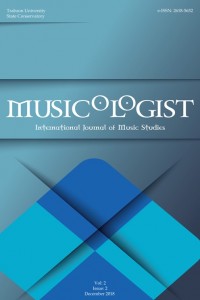Abstract
References
- Agawu, Kofi. (2006). “Il ritmo (Rhythm)” Enciclopedia della musica (Encyclopedia of Music). IX. (Special ed.), Ed. Jean-Jacques Nattiez.: 45-71. Torino – Milano: Giulio Einaudi editore – Il Sole 24 ORE. (2002).
- Arom, Simha. (1985). Polyphonies et polyrythmies instrumentales d’Afrique Centrale: structure et méthodologie (Instrumental Polyphony and Polyrhythmy from Central Africa: Structure and Methodology). (Vols. 1-2). Paris: SELAF.
- Galitskaya, Savolina; Mazepus, Vladimir (Eds.) (1997). Muzykal’naya kul’tura Sibiri. (Musical Culture of Siberia). (Vol 1.Part 1). Traditsionnaya kul’tura korennykh narodov Sibiri (Traditional Culture of Indigenous Peoples of Siberia). Novosibirsk: NSC.
- Eliferenko, Larissa. (2015). “Tipovye napevy pesennoy traditsii esinskikh sagaytsev” (Model Tunes of the Song Tradition of the Es’ Sagais). Master thesis, Novosibirsk: NSC.
- Jacobs, Arthur. (1965). A New Dictionary of Music.(5th ed.). Baltimore: Penguin Books. [1958]
- Kharlap, Miron. (1967). “Metr” (Meter). Kratkaya literaturnaya entsiklopedia (Short Literary Encyclopedia). (Vol. 4): 807-809. Moscow: Sov. Encyclopedia.
- Kharlap, Miron. (1976). “Metr” (Meter). Muzykal’naya entsiklopedia (Musical Encyclopedia). (Vol. 3): 567-573. Moscow: Sov. Encyclopedia; SovKompositor.
- Kharlap, Miron. (1974). “Metr” (Meter). Bol’shaya sovetskaya entsiklopedia (Big Soviet Encyclopedia). (3rd ed.) (Vol. 16): 167-168. Moscow: Sov. Encyclopedia.
- Longman. (1984). Longman Dictionary of the English Language. Harlow: Longman.
- Pinzhina, Olesia. (2007). “Tipovye napevy pesennoy traditsii tёyskikh sagaytsev”(Model Tunes of the Song Tradition of the Tёya Sagais). Master thesis, Novosibirsk: NSC.
- Sychenko, Galina. (1989). “Pesennaya poezia t’urkov Gornogo Altaya” (Sung Poetry of the Turks of Gorny Altai). Master thesis, Novosibirsk: NSC.
- Sychenko, Galina. (1998). “Traditsionnaya pesennaya kul’tura altaitsev” (Traditional Song Culture of Altaians). PhD Dissertation, Novosibirsk State Conservatory named after M.I. Glinka, Novosibirsk: NSC (unpublished manuscript).
- Sychenko, Galina. (2010). “Muzycal’no-poeticheskie traditsii shorskogo fol’klora” (Musical-Poetical Traditions of the Shor Folklore). Fol’klor shortsev: V zapis’akh 1911, 1925-30, 1959-60, 1974, 1990-2007 godov, Ed. Liubov’ Arbachakova: 41-68. Novosibirsk: Nauka.
- Sychenko, Galina; Krupich, Ekaterina and Pinzhina, Olesia. (2006) “ ‘Tipovye napevy’ v intonatsionnykh kul’turakh t’urkov Yuzhnoy Sibiri: problem izucheniya”. (‘Model Tunes’ in Intonational Cultures of the Turks of South Siberia: Problems of Study). Narodnaya kul’tura Sibiri. Materialy nauchnogo seminara-simpoziuma Sibirskogo regional’nogo vuzovskogo tsentra po fol’kloru, Ed. Tatiana Leonova: 36-40. Omsk: OmGPU.
- Tiron, Ekaterina. (2018). Pesni tuvintsev-todzhintsev: zhanry yr i kozhamyk v kontse XX stoletiya (Songs of the Tuva-Toju: Genres Yr and Kozhamyk at the End of XX Century). Novosibirsk: Nauka.
Abstract
The article is devoted to the so-called ‘sung
poetry’ of several Turkic-speaking peoples of South Siberia. The author’s main
focus is on the problem of metric organization of poetic and musical parameters
and the interrelations between them.
The author starts with a discussion of some
methodological issues, in particular, what can be regarded as ‘meter’ in vocal
folk music. Contrary to some authors, who attribute this term exclusively to
poetic expression, in this article it is understood in a broader sense: as a
system of temporal organization.
In Altai, Tuva, Shor, and Khakass song
traditions, there is a ‘syllabic rhythmical formula’ (SRF), which corresponds
to the verses, as well as to the melodic line. The SRF, following the author’s
opinion, can be regarded as a meter for a song, or the song as genre. It
usually regulates number and quality of musical units in correspondence with
the syllables.
This common and rather simple picture, nevertheless, becomes
more complicated when the author starts to describe some particular cases. The
traditions of the Telengits, Chalkans and Kumandins, Shors, and
Khakasses-Sagays are chosen to demonstrate a variety of arrangements of the of
‘sung poetry’ of the South Siberian Turks.
References
- Agawu, Kofi. (2006). “Il ritmo (Rhythm)” Enciclopedia della musica (Encyclopedia of Music). IX. (Special ed.), Ed. Jean-Jacques Nattiez.: 45-71. Torino – Milano: Giulio Einaudi editore – Il Sole 24 ORE. (2002).
- Arom, Simha. (1985). Polyphonies et polyrythmies instrumentales d’Afrique Centrale: structure et méthodologie (Instrumental Polyphony and Polyrhythmy from Central Africa: Structure and Methodology). (Vols. 1-2). Paris: SELAF.
- Galitskaya, Savolina; Mazepus, Vladimir (Eds.) (1997). Muzykal’naya kul’tura Sibiri. (Musical Culture of Siberia). (Vol 1.Part 1). Traditsionnaya kul’tura korennykh narodov Sibiri (Traditional Culture of Indigenous Peoples of Siberia). Novosibirsk: NSC.
- Eliferenko, Larissa. (2015). “Tipovye napevy pesennoy traditsii esinskikh sagaytsev” (Model Tunes of the Song Tradition of the Es’ Sagais). Master thesis, Novosibirsk: NSC.
- Jacobs, Arthur. (1965). A New Dictionary of Music.(5th ed.). Baltimore: Penguin Books. [1958]
- Kharlap, Miron. (1967). “Metr” (Meter). Kratkaya literaturnaya entsiklopedia (Short Literary Encyclopedia). (Vol. 4): 807-809. Moscow: Sov. Encyclopedia.
- Kharlap, Miron. (1976). “Metr” (Meter). Muzykal’naya entsiklopedia (Musical Encyclopedia). (Vol. 3): 567-573. Moscow: Sov. Encyclopedia; SovKompositor.
- Kharlap, Miron. (1974). “Metr” (Meter). Bol’shaya sovetskaya entsiklopedia (Big Soviet Encyclopedia). (3rd ed.) (Vol. 16): 167-168. Moscow: Sov. Encyclopedia.
- Longman. (1984). Longman Dictionary of the English Language. Harlow: Longman.
- Pinzhina, Olesia. (2007). “Tipovye napevy pesennoy traditsii tёyskikh sagaytsev”(Model Tunes of the Song Tradition of the Tёya Sagais). Master thesis, Novosibirsk: NSC.
- Sychenko, Galina. (1989). “Pesennaya poezia t’urkov Gornogo Altaya” (Sung Poetry of the Turks of Gorny Altai). Master thesis, Novosibirsk: NSC.
- Sychenko, Galina. (1998). “Traditsionnaya pesennaya kul’tura altaitsev” (Traditional Song Culture of Altaians). PhD Dissertation, Novosibirsk State Conservatory named after M.I. Glinka, Novosibirsk: NSC (unpublished manuscript).
- Sychenko, Galina. (2010). “Muzycal’no-poeticheskie traditsii shorskogo fol’klora” (Musical-Poetical Traditions of the Shor Folklore). Fol’klor shortsev: V zapis’akh 1911, 1925-30, 1959-60, 1974, 1990-2007 godov, Ed. Liubov’ Arbachakova: 41-68. Novosibirsk: Nauka.
- Sychenko, Galina; Krupich, Ekaterina and Pinzhina, Olesia. (2006) “ ‘Tipovye napevy’ v intonatsionnykh kul’turakh t’urkov Yuzhnoy Sibiri: problem izucheniya”. (‘Model Tunes’ in Intonational Cultures of the Turks of South Siberia: Problems of Study). Narodnaya kul’tura Sibiri. Materialy nauchnogo seminara-simpoziuma Sibirskogo regional’nogo vuzovskogo tsentra po fol’kloru, Ed. Tatiana Leonova: 36-40. Omsk: OmGPU.
- Tiron, Ekaterina. (2018). Pesni tuvintsev-todzhintsev: zhanry yr i kozhamyk v kontse XX stoletiya (Songs of the Tuva-Toju: Genres Yr and Kozhamyk at the End of XX Century). Novosibirsk: Nauka.
Details
| Primary Language | English |
|---|---|
| Journal Section | Articles |
| Authors | |
| Publication Date | December 29, 2018 |
| Published in Issue | Year 2018 Volume: 2 Issue: 2 |


